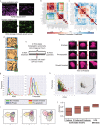High accuracy label-free classification of single-cell kinetic states from holographic cytometry of human melanoma cells
- PMID: 28931937
- PMCID: PMC5607248
- DOI: 10.1038/s41598-017-12165-1
High accuracy label-free classification of single-cell kinetic states from holographic cytometry of human melanoma cells
Abstract
Digital holographic cytometry (DHC) permits label-free visualization of adherent cells. Dozens of cellular features can be derived from segmentation of hologram-derived images. However, the accuracy of single cell classification by these features remains limited for most applications, and lack of standardization metrics has hindered independent experimental comparison and validation. Here we identify twenty-six DHC-derived features that provide biologically independent information across a variety of mammalian cell state transitions. When trained on these features, machine-learning algorithms achieve blind single cell classification with up to 95% accuracy. Using classification accuracy to guide platform optimization, we develop methods to standardize holograms for the purpose of kinetic single cell cytometry. Applying our approach to human melanoma cells treated with a panel of cancer therapeutics, we track dynamic changes in cellular behavior and cell state over time. We provide the methods and computational tools for optimizing DHC for kinetic single adherent cell classification.
Conflict of interest statement
The authors declare that they have no competing interests.
Figures




Similar articles
-
Accurate label-free 3-part leukocyte recognition with single cell lens-free imaging flow cytometry.Comput Biol Med. 2018 May 1;96:147-156. doi: 10.1016/j.compbiomed.2018.03.008. Epub 2018 Mar 14. Comput Biol Med. 2018. PMID: 29573668 Free PMC article.
-
Evaluation of holographic imaging cytometer holomonitor M4® motility applications.Cytometry A. 2018 Nov;93(11):1125-1131. doi: 10.1002/cyto.a.23635. Epub 2018 Oct 21. Cytometry A. 2018. PMID: 30343513 Free PMC article.
-
Movies of cellular and sub-cellular motion by digital holographic microscopy.Biomed Eng Online. 2006 Mar 23;5:21. doi: 10.1186/1475-925X-5-21. Biomed Eng Online. 2006. PMID: 16556319 Free PMC article.
-
Mass cytometry: blessed with the curse of dimensionality.Nat Immunol. 2016 Jul 19;17(8):890-5. doi: 10.1038/ni.3485. Nat Immunol. 2016. PMID: 27434000 Review.
-
Sample and substrate preparation for exploring living neurons in culture with quantitative-phase imaging.Methods. 2018 Mar 1;136:90-107. doi: 10.1016/j.ymeth.2018.02.001. Epub 2018 Feb 10. Methods. 2018. PMID: 29438830 Review.
Cited by
-
Quantitative phase imaging of adherent mammalian cells: a comparative study.Biomed Opt Express. 2019 May 14;10(6):2768-2783. doi: 10.1364/BOE.10.002768. eCollection 2019 Jun 1. Biomed Opt Express. 2019. PMID: 31259050 Free PMC article.
-
AutoCellANLS: An Automated Analysis System for Mycobacteria-Infected Cells Based on Unstained Micrograph.Biomolecules. 2022 Feb 1;12(2):240. doi: 10.3390/biom12020240. Biomolecules. 2022. PMID: 35204741 Free PMC article.
-
Cell viscoelasticity is linked to fluctuations in cell biomass distributions.Sci Rep. 2020 May 4;10(1):7403. doi: 10.1038/s41598-020-64259-y. Sci Rep. 2020. PMID: 32366921 Free PMC article.
-
Viscoelasticity, Like Forces, Plays a Role in Mechanotransduction.Front Cell Dev Biol. 2022 Feb 9;10:789841. doi: 10.3389/fcell.2022.789841. eCollection 2022. Front Cell Dev Biol. 2022. PMID: 35223831 Free PMC article. Review.
-
Label-Free High-Throughput Leukemia Detection by Holographic Microscopy.Adv Sci (Weinh). 2018 Oct 11;5(12):1800761. doi: 10.1002/advs.201800761. eCollection 2018 Dec. Adv Sci (Weinh). 2018. PMID: 30581697 Free PMC article.
References
-
- Henriksen M, Miller B, Newmark J, Al-Kofahi Y, Holden E. Laser scanning cytometry and its applications: a pioneering technology in the field of quantitative imaging cytometry. Methods Cell Biol. 2011;102:161–205. - PubMed
-
- Taylor, D. L., Haskins, J. R. & Giuliano, K. A. High content screening: a powerful approach to systems cell biology and drug discovery. (Humana Press, 2007).
Publication types
MeSH terms
Grants and funding
LinkOut - more resources
Full Text Sources
Other Literature Sources
Medical

